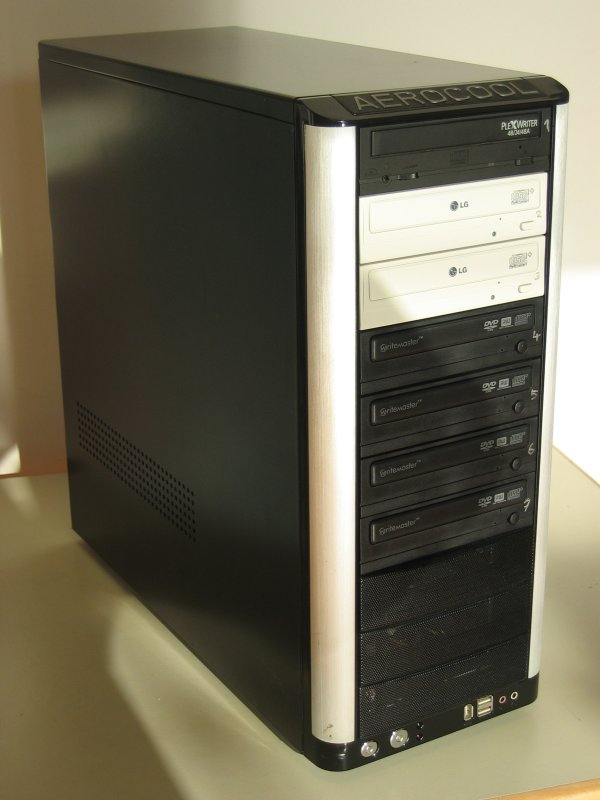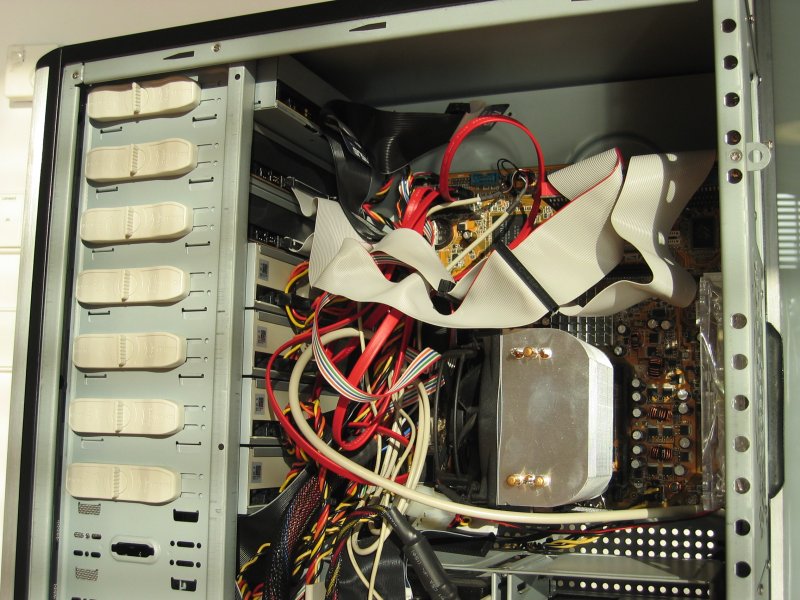The TurboJet CD/DVD Duplicator
Writing CDs and DVDs on demand
The story of the development
In 2004, my church (FEG München Mitte, located in the center of Munich, Germany) decided to renovate its building and
to buy new technical equipment. Before the change we offered our sermons on MC and CD but the most people decided to buy MCs because
they did not knew that we were offering CDs. Our MC duplicator was a rather old model with bad sound quality and seemed as some mechanical
parts were reaching the end of their life time. Buying a new MC duplicator costs around 1500 € which we thought was too expensive. We
were looking forward to buy a CD duplicator machine available on the market but they all had some features missing: Mostly you were only able
to copy from a master CD, and those were you also could read from a network device were only able to write one CD image at a time.
Our requirements were different as we needed just to burn the CD the visitors of our sermon wanted. Normally, they do not all come at once and
often they want to buy CDs from past sermons. In addition, we did not want to store our sermons on CD but rather on a RAID1 system.
What we needed was just a computer with as many CD Writers as possible. However, I knew that on one IDE bus you can only have one CD Writer
at once and you should not have the hard drive connected together with a CD Writer. But what I found out was, that Linux is capable of writing
to many CD Writers at once without problems as it caches the write and read access to the file system using the whole amount of free memory.
Getting it working
First I thought I could use SCSI CD Writers to get around the limitations of the IDE bus. But there were no SCSI writers available on the market anymore.
So I looked if I could use S-ATA CD Writers but there were only two drives available, one from Plextor and one from Samsung. First, I tried out to use
an additional IDE PCI adaptor card and connect two more CD Writers to it. I figured out that this did the job and the payload on the system while
writing to two CDs was minimal. However, I knew that installing more than one BIOS from additional IDE and SCSI adaptors can cause trouble
and the PCI bus has some speed limitations, too. While building the new computer I bought one S-ATA burner first. It was a Samsung SH-W163A which
made me trouble as the Linux kernel had only experimental support for ATAPI over S-ATA at this point of time. In addition the main board I bought,
an Asus A8N-VM CSM had a broken BIOS which did not want to start if I connected a S-ATA CD Writer to two of the four S-ATA connectors. By the way,
it also had a broken APIC table which lead to many broken interrupts. After I got the Samsung drive working I decided to buy three more CD Writers
increasing the total CD Writer count to seven. Now my CD/DVD Duplicator machine looks like this:

In the mean time, ASUS was able to release better BIOS versions and I updated the kernel to the latest version available. This stabilised the whole thing
and I am happy that I can say that all seven CD Writers are working, at once!
The software part
Beside the development of a machine where I can put many CD Writers together I started early on working a GUI front end to cdrecord where I can control
as many cdrecord childs as possible. Instead of focusing on creating different forms of creating CD and DVD images my front end was intended just to control
the CD writing process so you have to use another program to make CD images first. I started creating the software long time before building the machine and
I did the first tests with two USB CD Writers attached which gave me good results as well. The GUI looks like this at the moment:

(This is not a screen shot taken from the machine I built but from my development system)
Using this software it is easy to use all the seven CD Writers at once with different image files.
At the moment we store our sermons as PCM Wave Audio on our server, a Debian machine with 300GB RAID1 and Gigabit Ethernet. We write the sermon
directly from a samba share (Gigabit Ethernet makes it possible) which is absolutely no problem as Linux will cache the data in its memory. I do not need to tweak
cdrecord at all, it is working fine and as I tested writing four different images on seven CD Writers it did not need to use Burnfree once although I have only
512 MB RAM installed. The software is available from the Sourceforge CVS and there are also
Tarballs available but they might not be up to date.
Spreading god's word
In our church we are using this system to give our preaching and sermons away. Without god's blessings I would not have been able to do something like that
and I am sure that this can be a great tool to spread god's word. I am not interested in making money with it, instead I am offering to build or help building such machines including
a working installation of Debian GNU/Linux and TurboJet GUI to everybody who intend to use it for sharing and spreading the gospel all over the world like Jesus said in
Matthews 28,19-20: "Therefore go and make disciples of all nations, baptising them in the name of the Father and of the Son and of the Holy Spirit,20 and teaching them to obey everything I have commanded you. And surely I am with you always, to the very end of the age."
If you like it and you want to use it for other purposes, feel free to donate to my church. As I noticed at the
beginning, this software was created as a result of the renovation of our building and financial help is appreciated at the moment ;-). Please contact me at
weisgerber-at-mytum.de

Enhancements
At the moment I am looking forward to build a stand alone recording and duplicating PCs as I know that the most churches do not have own servers with in their building
nor do they have Gigabit Ethernet. We have made good experience with Terratec's Phase 22 sound card which has professional sound inputs and is not very expensive.
I am very interested to see if I will find bottle necks somewhere when writing from hard disk but I hope that today's PCs should have enough I/O throughput.
Some more shots







